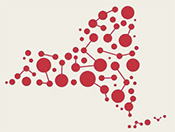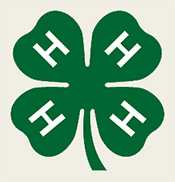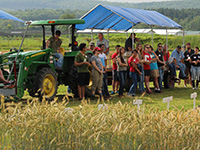Adapt these activities to the age, interest, and skill levels of your group.
Beginners Guide to Garden Art (pdf)
Plant a Rainbow(pdf)
Plants Used in Art Projects(pdf)
Connections to NYS Learning Standards
Capturing the beauty of plants through art is a great project – but why not take it one step further and grow an actual art garden? With a little planning, and a whole lot of creativity, you can create a garden that is both functional and ornamental: in other words, the garden provides the art materials you’ll need for your projects, as well as the inspiration for your artistic creations!
Everything that you plant in an art garden can have some functional use as an art material. Certain flowers and foods produce dyes for painting and textile projects, grasses provide fibers for weaving and making paper, and other plants can be dried for decoration and fragrance. You’ll soon realize the immense satisfaction in growing plants that you can then use as materials for your art projects!
Design:
- Engage youth in the process of designing and planning the art garden. Decide on a group design process that works well for all.
- To begin, you might take a look at some examples of garden plans. Many art gardens are featured in the book Schoolyard Mosaics: Designing Gardens and Habitats, published by the National Gardening Association.
- Be sure to check out Sowing the Seeds of Success (pdf), a great resource which gives a step-by-step approach on how to design a garden with youth.
- You might proceed by brainstorming ideas of art projects and the materials needed to make them. Alternatively, you could brainstorm a list of potential plants for the garden and identify the type of art materials they will provide (i.e. fibers, dyes, fragrance, etc.)
- For a list to get you started, see Plants Used in Art Projects(pdf).
- Once a list has been generated, as a group, walk around the garden site and discuss possible designs and planting locations.
Create:
- This will probably be the most challenging, as well as the most exciting part of growing an art garden – figuring out what to do with everything once it has grown! This is when the imagination can go wild with ideas and when you can start experimenting with ideas.
Click here for a brief article on an art garden (pdf) constructed in Fall 2009 at Smith School in Ithaca, NY. Designed and planned by a high school student, the garden is for students in Smith’s exceptional education program and features plants to use in art projects as well as a quiet space for reading or small group work.
top
Connections to NYS Learning Standards
Activity: PLANT A RAINBOW
Health, Physical Education, and Home Economics
STANDARD 1 Students will have the necessary knowledge and skills to establish and maintain physical fitness, participate in physical activity, and maintain personal health. Students will use an understanding of the elements of good nutrition to plan appropriate diets.
STANDARD 2 Students acquire knowledge/ability necessary to maintain a healthy environment. Students develop community approaches which enhance and protect the quality of the environment. Students develop skills of cooperation and collaboration.
STANDARD 3 Students understand the kinds of resources available in their community and make informed decisions related to their own use. Students participate in a school community service project. like a garden/habitat area. Students use recycled & found materials.
Mathematics, Science, and Technology
STANDARD 1 Students use mathematical analysis, scientific inquiry, and engineering design to pose questions and develop solutions.
STANDARD 2 Students access, generate, process, and transfer information using technologies from printed media and community resources.
STANDARD 3 Students understand math and become mathematically confident by communication and reasoning. Look at recurring patterns.
STANDARD 4 Students understand and apply scientific concepts, principles, and theories. Plant seeds and seedlings.
STANDARD 5 Students apply technological knowledge and skills to design, construct, use, and evaluate products. Students as a group plan and implement a project that can improve the quality of the school or community environment.
STANDARD 6 Students understand and apply relationships and common themes that connect math, science, and technology. Students collect and analyze data.
STANDARD 7 Students apply knowledge and skills of math, science, and technology to address problems. Students learn how to improve their environment.
English Language Arts
STANDARD 1 Students listen, speak, read, and write for information and understanding. Students collect data, facts, and ideas, discovering relationships, concepts, and generalizations, and using knowledge from oral, written, and electronic sources.
STANDARD 4 Students listen, speak, read, and write for social interaction. Students share with others including family and community with signage and informational brochures.
The Arts
STANDARD 2 Students make use of materials and resources for participation in the arts (rainbow collages).
STANDARD 3 Students will analyze visual characteristics of the natural environment and explain social, cultural, psychological, and environmental dimensions of the visual arts. Students respond critically to variety of works in the arts in the production of film.
STANDARD 4 Students understand personal and cultural forces that shape artistic communications. Students explore concept of art made with nature.
top









